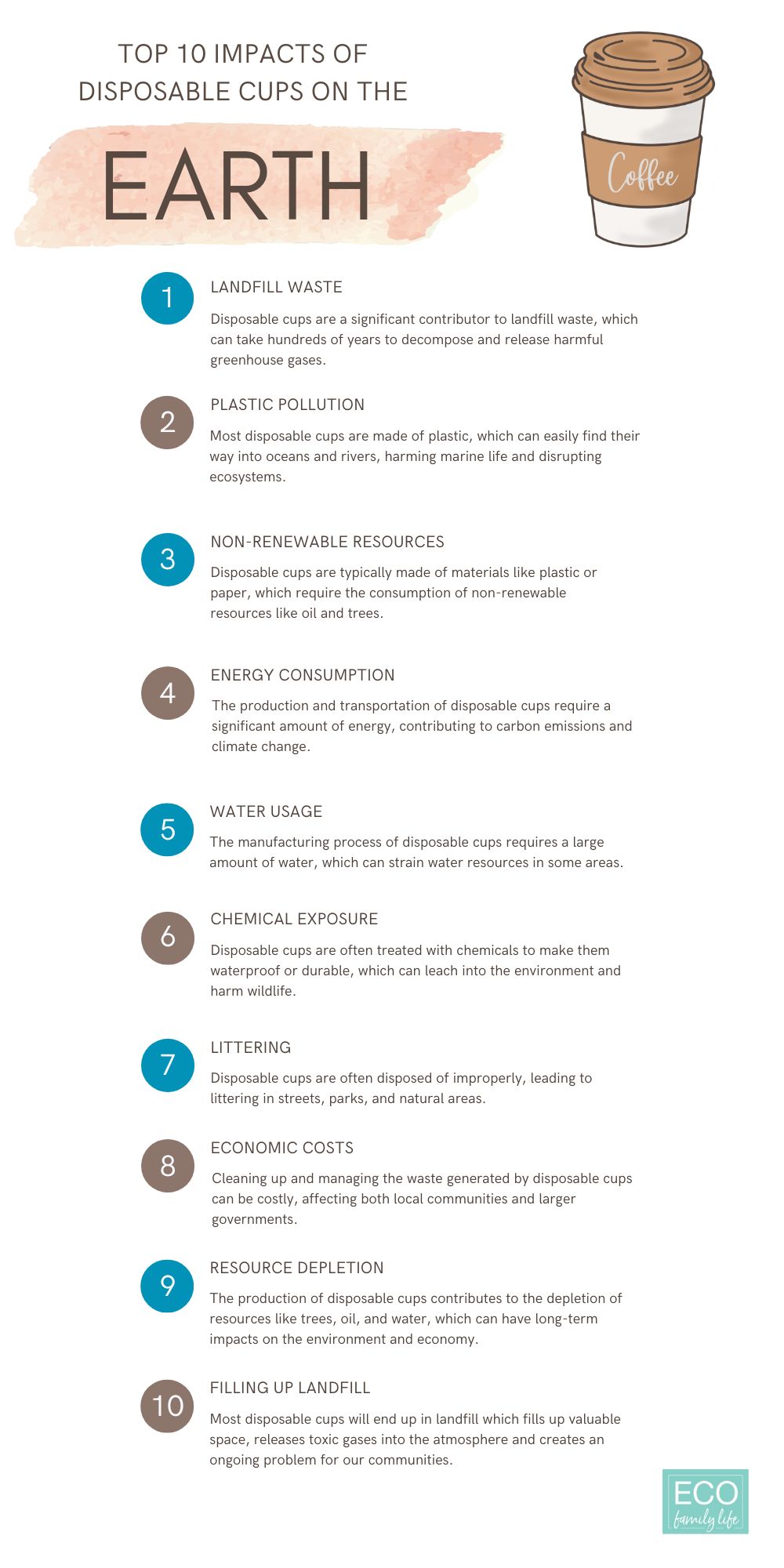Disposable coffee cups have a negative impact on the environment. They add more garbage landfill, increase plastic pollution in oceans and use up valuable resources such as paper. The US uses around 108 billion disposable cups per year and worldwide it is estimated that 500 billion are discarded to landfill each year.

Swapping disposable coffee cups to reusable is one way to reduce their environmental impact.
Let’s explore disposable cups environmental impact.
How many disposable cups we use
Coffee cups are the second biggest contributor to garbage second only to plastic bottles. The US uses around 108 billion cups per year. Worldwide it is estimated that 500 billion disposable cups are discarded to landfill each year.
That is equal to one million cups every minute.
The explosion of the cafe culture around the world has meant that more disposable cups are being thrown out. Many of us don’t have time to sit down in our local cafe and enjoy a leisurely coffee at our own pace.
If you have young kids like me, you will understand how tricky it is to sit down and finish a whole coffee without whining or cutlery being spread throughout the cafe.
It’s only recently that this habit of grabbing a takeaway coffee is being recognised as having a huge impact on our environment.
Top 10 impacts of disposable cups on the environment

Why disposable cups are a problem
Disposable cups are bad for the environment for several reasons. Firstly, they are usually made from paper or plastic, which requires a significant amount of energy and resources to produce.
Disposable cups are often not recycled and end up in landfills or as litter, where they can take hundreds of years to decompose.
The production and disposal of disposable cups contribute to air and water pollution, greenhouse gas emissions, and deforestation. All of these factors make disposable cups a major environmental problem that needs to be addressed.
What happens to disposable cups when we throw them out
Depending on where disposable coffee cups are thrown out they can end up in any number of places. If they are disposed of at home or when we are out and about in a normal bin they will end up in landfill.
The unfortunate thing about takeaway coffee cups is that hardly any of them are truely recyclable. Virtually all contain a plastic coating on the inside of the cup that makes it incredibly difficult to process and seperate.
There are very few facilities that are able to recycle these cups. If they are placed in regular recycling bins, they can end up contaminating other recyclable materials because most facilities are unable to process them.
Alternatives to Disposable Cups
Disposable cups are a major contributor to environmental pollution however, there are several alternatives that you can use to reduce your carbon footprint.
Reusable Cups
One of the best alternatives to disposable cups is a reusable cup. Reusable cups are eco-friendly and can be used multiple times. They are available in different materials, such as glass, stainless steel, and bamboo. Some cafes even offer discounts to customers who bring their own cups.
Using a reusable cup is very easy. You can carry it with you wherever you go and use it to enjoy your favorite beverages. After use, you can wash it and reuse it again. Reusable cups are also very stylish, and you can choose one that matches your personality.
Biodegradable Options
Another alternative to disposable cups is biodegradable cups. Biodegradable cups are made from materials that decompose naturally and do not harm the environment. They are available in different materials such as paper, cornstarch, and sugarcane.
Biodegradable cups are a great option for those who cannot carry a reusable cup with them. They are lightweight and easy to dispose of. However, it is important to note that not all biodegradable cups are created equal. Some require specific conditions to decompose, such as high temperatures or humidity.
Here are some examples of biodegradable cups:
- Cornstarch cups: These cups are made from cornstarch and are biodegradable. They are not suitable for hot beverages.
- Sugarcane cups: These cups are made from sugarcane fiber and are biodegradable. They are suitable for hot and cold beverages.
Check out these cups made from coffee grounds in the video below.
Using reusable cups and biodegradable options are great alternatives to disposable cups. By making a small change in your daily routine, you can contribute to a cleaner and healthier environment.
The bigger picture
Some countries across the world are taking the lead when it comes to recycling and climate change. France are banning single use plastics, Germany has the Frieburg cup which a reusable cup and can be used at multiple outlets.
Customers give a small deposit (around $1) which gets refunded when they return the cup. It can be used up to 400 times and solves the problem of expecting everyone to bring their own reusable cup.
I think disposable cups are really just the starting point for our journey towards a more sustainable culture. I know I am starting to consider all of the items that I have been buying out of habit and starting to rethink my choices. From toothbrushes, straws, cups and shopping bags.
Summary
There is a lot to be concerned about when we look at how many disposable cups are being thrown out. Re-usable cups are a simple way we can reduce our waste and help to avoid loads of garbage filling up landfill spaces.
I am an accredited practicing dietitian, experienced gardener and a dedicated cook. I love writing and sharing my experience so you can learn from my successes and mistakes.
